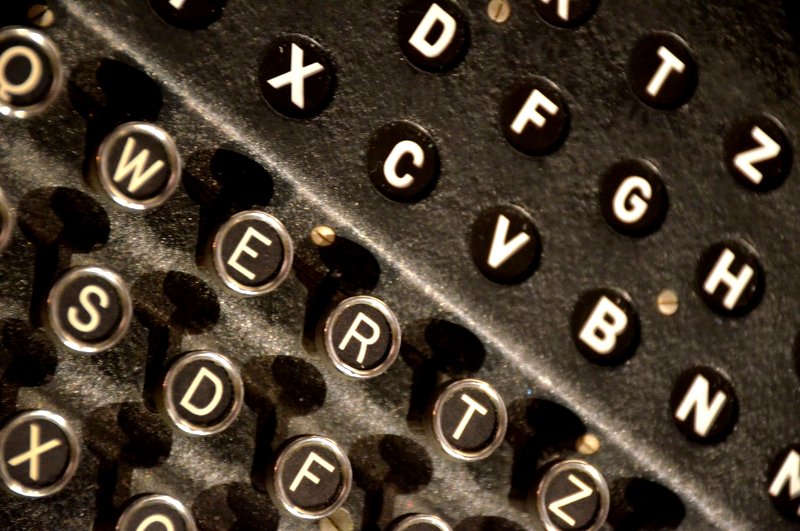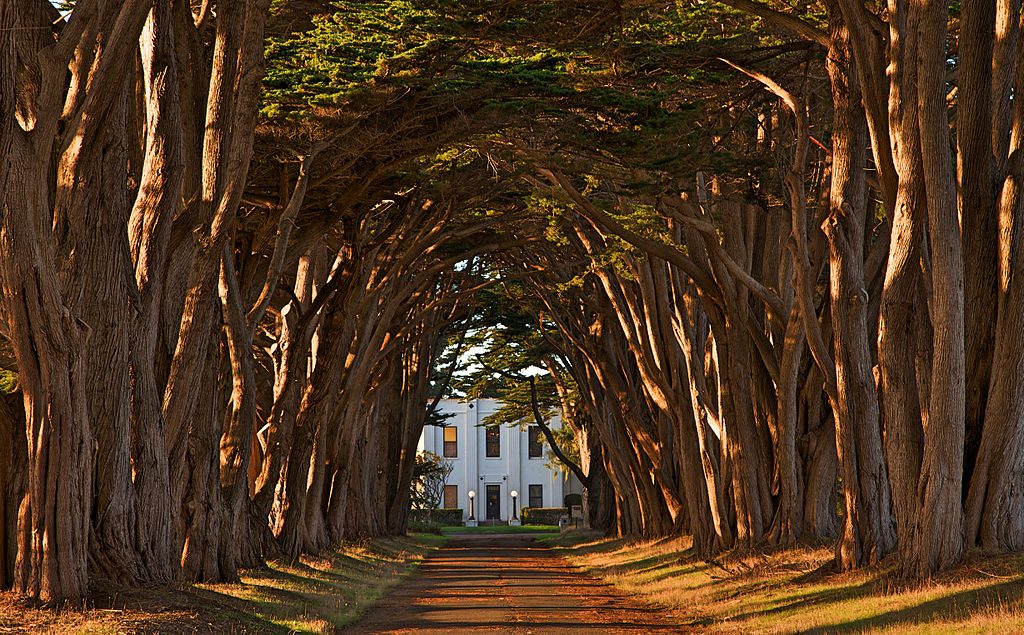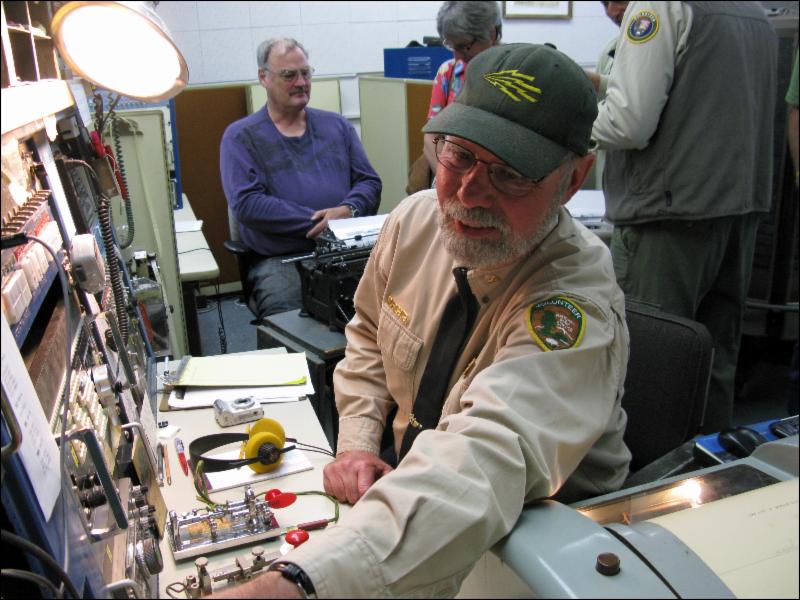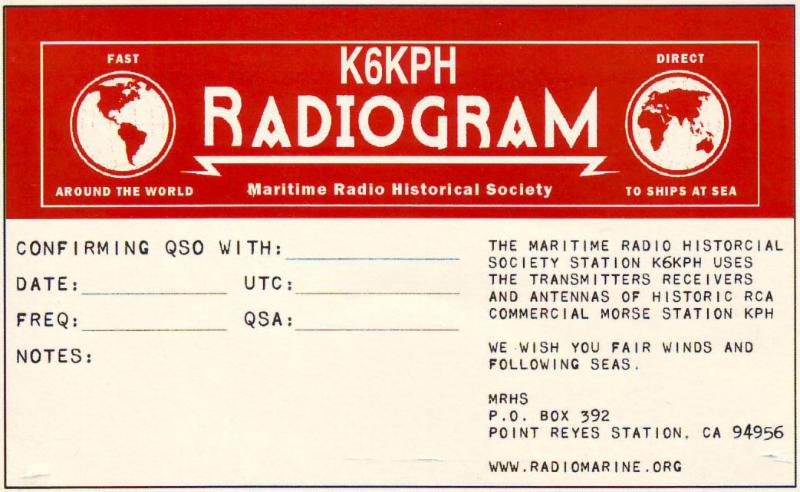 Many thanks to SWLing Post contributor Paul Jamet, who notes that the Maritime Radio Historical Society is hosting another Crypto Transmission from KPH on Saturday, August 30, 2025 at 20:00 UTC.
Many thanks to SWLing Post contributor Paul Jamet, who notes that the Maritime Radio Historical Society is hosting another Crypto Transmission from KPH on Saturday, August 30, 2025 at 20:00 UTC.
Tag Archives: Maritime Radio Historical Society of America
KHP: An over-the-air cryptographic challenge on January 20, 2024
 Many thanks to SWLing Post contributor, Paul (KW1L), who writes:
Many thanks to SWLing Post contributor, Paul (KW1L), who writes:
The Maritime Radio Historical Society, in cooperation with our good friends at the Cipher History Museum, present a unique, over-the-air cryptographic challenge.
https://www.radiomarine.org/mrhs-events
On January 20 2024, KPH will transmit a coded message consisting of 5-digit groups. The message will be encrypted using typical Cold War numbers station cryptographic procedures. All KPH listeners are invited to try their hand at receiving and decrypting the message. Certificates will be awarded to those who successful decode the message. Additionally, a special certificate will be awarded to the first person to decode it.
Thank you, Paul!
Decode the Enigma: Crypto Transmission from KPH on Saturday, July 23, 2022
The Maritime Radio Historical Society is hosting a brilliant on-the-air event via KPH. I’ve pasted full details below, copies directly from the Maritime Radio Historical Society announcement:
ATTENTION ALL AGENTS!
Crypto Transmission from KPH!
Background
The MHRS in cooperation with our good friends at the Cipher History Museum
will send a coded message in 5-letter groups via the facilities of coast stations KPH on Saturday July 23, 2022. The message will be encrypted using the famous Enigma code machine.
All KPH listeners are invited to try their hand at receiving and decrypting the message. Certificates will be awarded for proof of successful decode, first to decode and use of original hardware.
Mislaid your Enigma code machine? In the military you’d have some explaining to do, soldier. But for the KPH Crypto Event, no problem. See the ‘Enigma Simulator’ section below for a link to an easy-to-use Enigma simulator.
Enigma
The Enigma was the Germans’ most sophisticated coding machine for securely transmitting command and control messages via radio communications in WWII. It was considered so secure that it was used to encipher the most top-secret of messages.
The arrangement of Enigma’s rotors and plugboard connections provided a unique series of letter substitutions which changed with each keystroke. The daily rotor order and the ring and plugboard settings to be used were specified in a codebook distributed monthly to all users of a network.
For additional information on the Enigma please see Ralph Simpsons’ Cipher Museum History site
Crypto broadcast date, time and formats.
The crypto broadcast will commence at 2000Z (1300 Pacific) on 23 July on all KPH CW frequencies. The broadcast will consist of a ‘callup’ (in plain text) announcing the broadcast, followed by the cipher message. The callup and cipher messages will be sent at 15 WPM. The cipher message will be sent in 5 letter groups and the message will be sent twice to ensure proper reception.
The usual KPH channel marker or ‘wheel’ running at 20 WPM will precede the announcement for the crypto broadcast to give listeners a chance to tune to the strongest signal in their area.
The KPH CW frequencies are (in kc):
-
- 426 (after an announcement on 500)
- 4247.0
- 6477.5
- 8642.0
- 12808.5
- 17016.8
- 22477.5
Upon completion of the CW transmissions, the broadcast will be repeated on all KPH RTTY frequencies. The RTTY transmission will be 170cps shift Baudot, 45 baud.
The KPH RTTY frequencies are (in kc):
-
- 6324.5
- 8427.0
- 12585.5
Code Machine Key Settings – IMPORTANT!
Decoding an Enigma message requires the use of two keys: a Daily Key (valid for particular day), and a Message Key (unique to each individual message sent that day).
The Daily Key
Prior to decoding a message, the daily key must be set into your Enigma code machine. The daily key settings were specified in codebooks and distributed monthly. Please consult the following codebook to obtain the daily key setting for the GMT date of the broadcast.
Click HERE for the Enigma codebook. Use the “Armee-Stabs-Maschinenschlussel No 28” (Army Staff Machine Key Number 28). Notice each daily setting is across one line, starting with the first day of the month on the bottom of the sheet.
The Message Key
Starting in 1940, for additional security, the machine operator would randomly choose two groups of three letters to encode each message (in addition to the daily key settings above). These were known as the ‘message key’. The first group of three letters is used to encode the second group of three. Then the first group (in plaintext) and the second group (now encoded) are sent in the message header, along with the date and letter count, as explained in the above link. The recipient then uses the message key to decode the message. For more information see the following video on Enigma decoding procedures.
Click HERE to watch a video on Enigma coding procedures.
Enigma Simulators
So you had to toss your Enigma machine overboard when your U-boat was captured? Again, no worries. MHRS has you covered! Software simulations exist for the Enigma code machine.
Click HERE for an Enigma simulator. It is web-based, no download necessary.
Certificates
Upon proof of successful decode, the following certificates will be awarded:
– First to decode the Enigma message
– Successful decode using *original* hardware (i.e., an actual Enigma machine)
– All successful decodes of the message
To apply for a certificate, send the decoded message to [email protected] with the subject line ‘decoded Enigma message’. The First to Decode award will be based on the timestamp of the first email demonstrating a successful decode. For the Enigma Original Hardware certificate, send the decoded message *plus* a photo of your Enigma machine showing the daily key setting. Printed certificates will be mailed for ‘First-to-Decode and ‘Original Hardware’ awards. Certificates for ‘Successful Decode’ will be emailed in digital form suitable for printing at home.
More Information
For more information or questions about the KPH cipher broadcast send email to [email protected] with the subject line:
Crypto Broadcast
KPH Article on TechCrunch and Bay Area Backroads
Many thanks to SWLing Post contributor, Dan Van Hoy, who writes:
“The Last Radio Station,” an article about maritime radio station, KPH, is up on TechCrunch ( https://techcrunch.com/2020/01/18/the-last-radio-station/ ).
KPH is silent on maritime frequencies, but through the hard work of volunteers continues operation 24/7 with a 3-30MHz KiwiSDR receiver (http://198.40.45.23:8073/) and various activities throughout the year. Full information on all things KPH can be found the excellent Maritime Radio Historical Society Website (http://www.radiomarine.org/).
Finally an excellent “Bay Area Backroads” episode about KPH is available on Youtube:
Can you copy the CW message at the end of the show?
Please comment if you can copy the CW message!
Thanks to much for sharing this, Dan!
“Night of Nights” Returns Tonight!
Many thanks to SWLing Post contributor, Brian Smith (W9IND), who writes:
The cast may be smaller than in previous years, but the “Night of Nights” nostalgia show will go on. At 8:01 p.m. Eastern Time today (0001 UTC July 13), two maritime CW stations operated by the Maritime Radio Historical Society will begin transmitting Morse code on shortwave and medium wave bands, while the Society’s amateur radio station will be active on four ham bands.
Venerable KPH will reappear tonight in the company of KFS and ham station K6KPH, all transmitting from a century-old Marconi site at Bolinas, California. They’ll be directed from a 1930 RCA station at 17400 Sir Francis Drake Boulevard in Point Reyes National Seashore. Several previous participants will be absent this year, including ship-to-shore powerhouse WLO of Mobile, Alabama, and a quartet of Coast Guard stations.
The annual July 12 event commemorates the date in 1999 when commercial Morse code operations ceased in the United States. One year later, “Night of Nights” debuted in a defiant declaration that maritime CW stations would not go gentle into that good night.
Typically, the two 5 kw coast stations transmit “code wheels” (repeating messages), personal messages, and tributes to long-gone maritime stations and operators, remaining on the air till at least 0700 UTC. And K6KPH will not only be heard, but contacted by fellow amateur radio stations. A list of KPH, KFS and K6KPH frequencies can be found at www.radiomarine.org, including those used by ships. Reception reports go to P.O. Box 392, Point Reyes Station, CA 94956.
The public is welcome to observe today’s event and tour the facility at Point Reyes. Doors open at 3 p.m. local (Pacific) time, and Morse aficionados are invited to operate K6KPH. Whisper the words “true believer” for a peek at the Treasure Room!
https://www.nps.gov/pore/planyourvisit/events_nightofnights.htm
For a comprehensive list of frequencies please click here.
Many thanks for the notice, Brian! We’ll tune in!
Guest Post: “Night of Nights” July 12, 2017
Many thanks to SWLing Post contributor, Brian Smith (W9IND), who shares the following guest post:
“Night of Nights” 2017
by Brian D. Smith, W9IND
“Night of Nights XVIII” – radio’s answer to “Night of the Living Dead” – will again unfold on July 12 (July 13 UTC) with the return of maritime Morse code transmissions that were thought to have died in 1999, but now haunt the shortwave and medium wave bands one night a year. The announced 2017 lineup brings both good and bad news, with venerable Coast Guard station NMN joining the active list while ship-to-shore heavyweight WLO stays on the sidelines.
For CW aficionados, the event offers not only an audio nostalgia trip, but a chance to obtain QSL cards and – for those in the San Francisco area – witness the event in person at the former KPH facility, located at Point Reyes National Seashore near San Francisco.
Amateur radio operators can get in on the fun by working the Maritime Radio Historical Society club station, K6KPH (via CW, of course) – and even operating it if they’re close enough to visit. The event organizers endorse amateur radio licenses with special stamps and “the Great MRHS Seal,” says Chief Operator Richard Dillman.
“Night of Nights” takes place annually on July 12 to mark the date in 1999 when commercial Morse code operations ceased in the United States. The six participating stations will take to the airwaves on multiple frequencies at 8:01 p.m. Eastern time on July 12 (0001 UTC July 13) and continue for several hours. Two MRHS stations, KPH and KFS, will beam signals from the original KPH transmitter site in nearby Bolinas, California, with a quartet of Coast Guard stations checking in from both coasts – NMC (California), NMN (Virginia), NMQ (California) and NMW (Oregon). The latter two will operate on medium wave frequencies only.
Follow this Maritime Radio Historical Society link for a complete list of participating stations, frequencies and other details: http://radiomarine.org/gallery/show?keyword=nonxi&panel=pab1_5#pab1_5
For the backstory on the KPH comeback and the tireless volunteer efforts that went into it, read “Who We Are” on the MRHS home page: http://www.radiomarine.org
This Point Reyes National Seashore page gives a historical perspective on the event: https://www.nps.gov/pore/planyourvisit/events_nightofnights.htm
This YouTube video from a 2012 visit provides an inside look at the MHRS operations: https://www.youtube.com/watch?v=Wj-IwYPrtTM
QSL requests for KPH, KFS and K6KPH go to:
Maritime Radio Historical Society
P.O. Box 392
Point Reyes Station, CA 94956
USA
QSL requests for NMC, NMN, NMQ and NMW go to:
ET1 Mike Leska
ESD Ketchikan – QSL
1300 Steadman St.
Ketchikan, AK 99901
USA
QSL requests to all stations should include an SASE – but no “green stamps” (dollar bills).
Here’s a sample K6KPH “Radiogram” QSL:
Here’s a sample Coast Guard QSL for NMC and NMQ:
Night of Nights XVI: July 12, 2016
Update: Please read Brian’s update regarding frequencies.
SWLing Post contributor, Brian D. Smith, writes:
“Thought I’d forward you this information on the annual “Night of Nights” event on July 12 (U.S. local time)/July 13 UTC, which provides an opportunity for shortwave QSLs – assuming the listener understands Morse code!
I’m sure you’re familiar with this one-night-a-year happening, in which maritime radio stations rise from the dead and transmit Morse code messages again for a few hours.
As a guy who honed his CW sending skills by listening to these stations’ constantly repeating messages, I have a sense of nostalgia and gratitude toward these stations, which helped me obtain my first Novice license, WN9ICB, at the age of 15 … less than 2 months after I taped the WWV recording that I submitted.”
Many thanks for the notice and sharing your nostalgia! Brian also forwarded an announcement from the Maritime Radio Historical Society of America. The MRHS describe the event:
It’s that time of year again. Time to honor all those ops who came before us by preserving their skills, traditions and culture through on the air operations.
Why 12 July? Long time True Believers know the story. But it may be worth repeating for new arrivals and to remind everyone of the traditions we hope to keep alive.
On 12 July 1999 some very tough looking grizzled old radio pioneers had tears in their eyes as the last commercial Morse code radiogram was sent. It was the end of an era. And as the last beeps faded away into the static they witnessed the end of the career to which they had devoted their lives.
These men – and some women – had stood watch over the airwaves on shore and at sea. Theirs was mostly the business of maritime commerce. But when their ship was in peril they were called upon to send the most electrifying three letters in radio, S O S, knowing that all their fellow radio operators would press their earphones close to get every scrap of information and bring aid to their stricken ship.
Once, our coasts were dotted with great Morse code radio stations, all communicating with ships at sea. They’re all gone now… all except one, the one they called the Wireless Giant of the Pacific, located at Point Reyes.
On that sad day in 1999 another event took place. The Maritime Radio Historical Society (MRHS) was formed. We made it our life’s work to honor the men and women of wireless by restoring that wireless giant. One year and one minute later the giant’s voice once again spanned the oceas as we picked up the thread and kept the faith with our colleagues of the air.
Every year since, in an event that became known as the Night of Nights, Morse code station KPH has returned to the air, joined by KFS and the station of the MRHS, KSM.
This year our friends and colleagues at USCG station NMC have labored mightily to bring that storied call sign back to life on Morse code for the evening along with NMQ in Cambria, CA..
And station NMW in Astoria, OR will be on the air as well.
Stations WLO and KLB will join us again as hey have in years past.
This is a global and local event. Hundreds of listeners around the world will be waiting with their earphones on, waiting for the signals of the great station to once again arc over the dome of the Earth to their receivers.
You can be with us in person!
The frequencies for this event are numerous! I have listed the USCG (NMC) frequencies below, but please check the MHRS newsletter for MRHS and other maritime station frequencies.
Again, Brian, thanks for the heads-up!
Happy listening, everyone!
NMC (Transmit Bolinas, Receive Pt. Reyes)
Frequency Transmitter Antenna
472.0 Nautel ND2500TT/6 173′ monopole tower
500.0 Nautel ND2500TT/6 173′ monopole tower
6383.0 Rockwell-Collins RT-2200 Omni-directional
8574.0 Rockwell-Collins RT-2200 Omni-directional
17220.5 Rockwell-Collins RT-2200 Omni-directional




